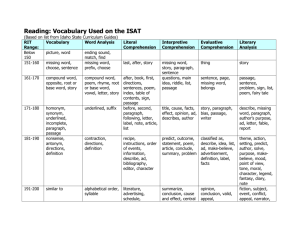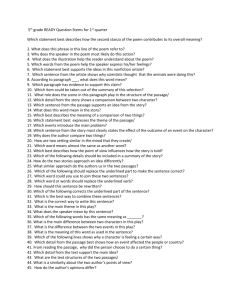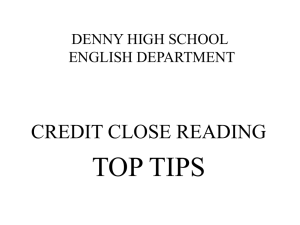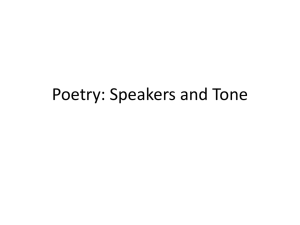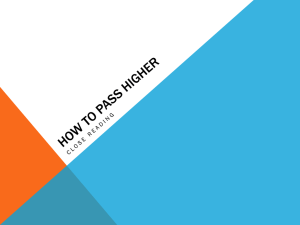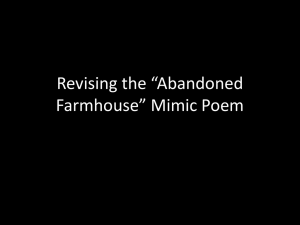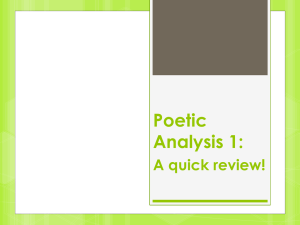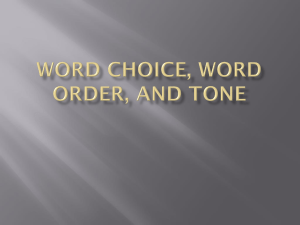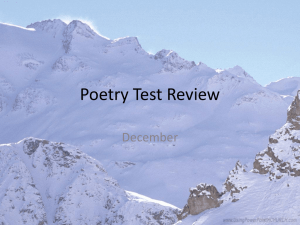Cracking the AP Literature Exam
advertisement
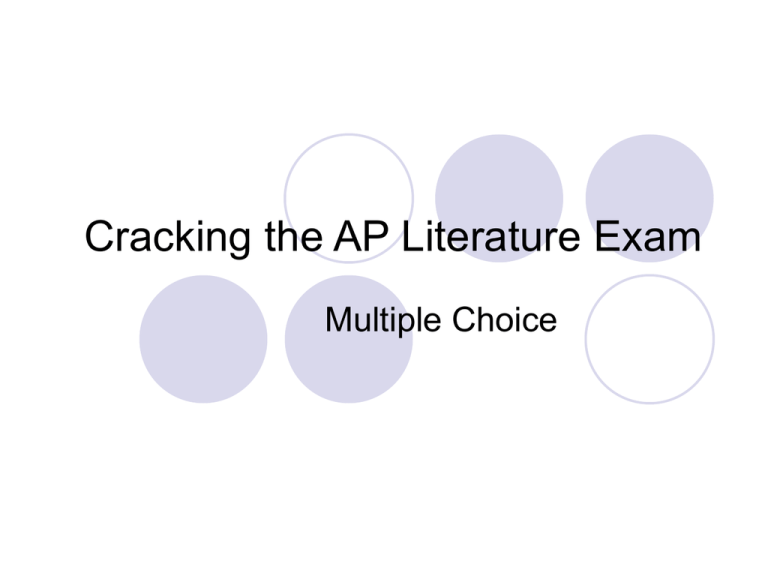
Cracking the AP Literature Exam Multiple Choice It is likely that at least passage is chosen from each of the following periods: Sixteenth or the early seventeenth century Restoration or eighteenth century Nineteenth century Twentieth century Within the Last 500 years! Reading the Multiple Choice Passages Pay attention to punctuation and rhythms of the lines or sentences. Read as if you were reading the passage aloud to an audience emphasizing meaning and intent. Hear the words in your head. Pay attention to the title, author, date of publication, and footnotes. Look for foreshadowing. Be aware of thematic lines and details. Pay attention to enjambment and end-stopped lines in poetry. The Straightforward Question The poem is an example of The word “smooth” refers to The question that refers you to specific lines and asks you to draw a conclusion or to interpret. Lines 52-57 serve to The “all . . . except” question These require extra time because they demand you consider every possibility. Make inferences or abstract a concept that is not directly stated in the passage In the poem “My Last Duchess,” the reader can infer that the speaker is Skip if you are short on time. Roman Numerals In the poem, “night” refers to I. The death of the maiden II. A pun on Sir Lancelot’s title III. The end of the affair Skip if you are short on time. Dramatic Situation Questions Speaker Male or female Where When Circumstances Audience Structure Questions Punctuation Repetitions How are stanzas 1 and 2 related to stanza 3? What word in line 20 refers back to an idea used in lines 5, 10, and 15? Which of the following divisions of the poem best represents its structure? Theme questions Which of the following best sums up the meaning of stanza 2? With which of the following is the poem centrally concerned? The poet rejects the notion of an indifferent universe because . . . . Images and figures of speech questions Expect a large number of these. Sensory objects Similes and metaphors (What is compared?) Pattern in the images To which of the following does the poet compare his love? The images in lines 3 and 8 come from what area of science? The figure of the rope used in line 7 is used later in the poem in line . . . . Single word questions Diction Which of the following words is used to suggest the poet’s dislike of winter? The poet’s use of the word “air” in line 8 is to indicate . . . . The poet’s delight in the garden is suggested by all of the following words EXCEPT . . . Tone questions These do not appear frequently. The tone of the poem can best be described as . . . . Literary devices questions Rhetorical devices Metaphor Simile Personification Which of the following literary techniques is illustrated by the phrase “murmurous hum an buzz of the hive”? Grammar questions Look carefully at the context. The obvious meaning of the word is usually not the one used in the poem. May exploit double meanings Which of the following best defines the word “glass” as it is used in line 9? To which of the following does the word “which” in line 7 refer? The verb “had done” may best be paraphrased as . . . . If no choice immediately strikes you as correct, you can Eliminate those that are obviously wrong. Eliminate those choices that are too narrow or too broad. Eliminate illogical choices. Eliminate answers that are synonymous. Eliminate answers that cancel each other out. If two answers are close, do one or the other of the following: Find the one that is general enough to cover all aspects of the question. Find the one that is limited enough to be the detail the question is looking for. If time is running out and you haven’t finished the fourth selection: Scan the remaining questions and look for: -the shortest questions -the questions that direct you to a specific line Look for specific detail/definition questions. Look for self-contained/direct questions. Poets Shakespeare John Donne Philip Larkin Emily Dickinson Sylvia Plath Dylan Thomas May Swenson Theodore Roethke Richard Wilbur Adrienne Rich Edmund Spencer W. H. Auden W. B. Yeats Gwendolyn Brooks Elizabeth Bishop Langston Hughes Prose Multiple Choice Genre questions From what kind of work is the selection taken? (fiction or nonfiction) Narrator questions Speaker Attitudes toward the characters or subject Who Where When Why audience Subject questions Purpose Structure questions Determine how each part (paragraph) advances the passage as a whole. Style questions Diction Imagery Figurative language Syntax Rhetoric (use of words to persuade or influence a reader) Situation and content questions The main subject of the passage is . . . . The primary distinction made in the first paragraph is between . . . . According to lines 3-7, which of the following is the chief . . . . In the third paragraph, the author is chiefly concerned with . . . . Meaning of words or phrases questions As it is used in line 2, the word ---- can be best understood to mean . . . . In line 7, the word ---- employs all of the following meanings EXCEPT . . . The phrase ----- is best understood to mean . . . . Diction questions The speaker’s choice of verbs in the paragraph is to stress the . . . . The speaker’s anger is suggested by all of the following EXCEPT . . . . Figurative language questions The comparison in lines 1-3 compares . . . The analogy of the second paragraph compares . . . . The phrase ----- is best read as a metaphor relating to . . . . The purpose of the astronomy metaphor in line 9 is to . . . . Structure questions The transitions from the first to the second and the second to the third paragraph are dependent upon . . . . The last paragraph of the passage is related to the first chiefly by . . . . Literary techniques questions In the third paragraph, the description of the cat on roller skates is an example of . . . . All of the following phrases are paradoxes EXCEPT . . . . The phrase “silent scream” is an example of . . . . Rhetoric questions The rhetorical purpose of lines 1-6 is to . . . The argument of the passage can be best described as progressing from . . . . Which of the following best describes the function of the last sentence? The effect of shifting from the past to the present tense in the third paragraph is . . . The happiness of the speaker is conveyed primarily by the use of . . . . Tone questions The tone of the passage may be described as . . . . In discussing ------ in the second paragraph, the speaker adopts a tone of . . . .
